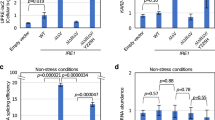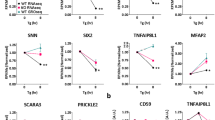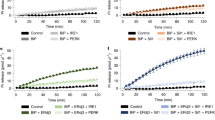Abstract
Poly(ADP-ribose) polymerases (PARPs; also known as ADP-ribosyl transferase D proteins) modify acceptor proteins with ADP-ribose modifications of varying length (reviewed in refs 1, 2, 3). PARPs regulate key stress response pathways, including DNA damage repair and the cytoplasmic stress response2,3,4,5,6. Here, we show that PARPs also regulate the unfolded protein response (UPR) of the endoplasmic reticulum (ER). Human PARP16 (also known as ARTD15) is a tail-anchored ER transmembrane protein required for activation of the functionally related ER stress sensors PERK and IRE1α during the UPR. The third identified ER stress sensor, ATF6, is not regulated by PARP16. As is the case for other PARPs that function during stress, the enzymatic activity of PARP16 is upregulated during ER stress when it ADP-ribosylates itself, PERK and IRE1α. ADP-ribosylation by PARP16 is sufficient for activating PERK and IRE1α in the absence of ER stress, and is required for PERK and IRE1α activation during the UPR. Modification of PERK and IRE1α by PARP16 increases their kinase activities and the endonuclease activity of IRE1α. Interestingly, the carboxy-terminal luminal tail of PARP16 is required for PARP16 function during ER stress, suggesting that it transduces stress signals to the cytoplasmic PARP catalytic domain.
This is a preview of subscription content, access via your institution
Access options
Subscribe to this journal
Receive 12 print issues and online access
$209.00 per year
only $17.42 per issue
Buy this article
- Purchase on Springer Link
- Instant access to full article PDF
Prices may be subject to local taxes which are calculated during checkout





Similar content being viewed by others
Change history
19 November 2012
the version of this Letter initially published online and in print, the reference (PLoS ONE 7, e37352; 2012) was inadvertently omitted from the reference list.
References
Hottiger, M. O., Hassa, P. O., Lüscher, B., Schüler, H. & Koch-Nolte, F. Toward a unified nomenclature for mammalian ADP-ribodyltransferases. Trends Biochem. Sci. 35, 208–219 (2010).
Schreiber, V., Dantzer, F., Ame, J. C. & de Murcia, G. Poly(ADP-ribose): novel functions for an old molecule. Nat. Rev. Mol. Cell Biol. 7, 517–528 (2006).
Hassa, P. O. & Hottiger, M. O. The diverse biological roles of mammalian PARPS, a small but powerful family of poly-ADP-ribose polymerases. Front Biosci. 13, 3046–3082 (2008).
Malanga, M. & Althaus, F. R. The role of poly(ADP-ribose) in the DNA damage signaling network. Biochem. Cell Biol. 83, 354–364 (2005).
Ménissier-de Murcia, J., Molinete, M., Gradwohl, G., Simonin, F. & de Murcia, G. Zinc-binding domain of poly(ADP-ribose)polymerase participates in the recognition of single strand breaks on DNA. J. Mol. Biol. 210, 229–233 (1989).
Leung, A. K. et al. Poly(ADP-ribose) regulates stress responses and microRNA activity in the cytoplasm. Mol. Cell. 42, 489–499 (2011).
Whitley, P., Elin Grahn, E., Kutay, U., Rapoport, T. A. & Heijne, G. A 12-residue-long polyleucine tail is sufficient to anchor. J. Biol. Chem. 271, 7583–7586 (1996).
Schuldiner, M. et al. The GET complex mediates insertion of tail-anchored proteins into the ER membrane. Cell 134, 634–645 (2008).
Borgese, N., Brambillasca, S. & Colombo, S. How tails guide tail-anchored proteins to their destinations. Curr. Opin. Cell Biol. 19, 368–375 (2007).
Lorenz, H., Hailey, D. W. & Lippincott-Schwartz, J. Fluorescence protease protection of GFP chimeras to reveal protein topology and subcellular localization. Nat. Methods 3, 205–210 (2005).
Kleine, H. et al. Substrate-assisted catalysis by PARP10 limits its activity to mono-ADP-ribosylation. Mol. Cell 32, 57–69 (2008).
Stephens, S. B., Dodd, R. D., Lerner, R. S., Pyhtila, B. M. & Nicchitta, C. V. Analysis of mRNA partitioning between the cytosol and endoplasmic reticulum compartments of mammalian cells. Methods Mol Biol. 419, 197–214 (2008).
Hamman, B. D., Chen, J. C., Johnson, E. E. & Johnson, A. E. The aqueous pore through the translocon has a diameter of 40–60 A during cotranslational protein translocation at the ER membrane. Cell 89, 535–544 (1997).
Sriburi, R., Jackowski, S., Mori, K. & Brewer, J. W. XBP1: a link between the unfolded protein response, lipid biosynthesis, and biogenesis of the endoplasmic reticulum. J. Cell Biol. 167, 35–41 (2004).
Harding, H. P., Calfon, M., Urano, F., Novoa, I. & Ron, D. Transcriptional and translational control in the Mammalian unfolded protein response. Annu. Rev. Cell Dev. Biol. 18, 575–599 (2002).
Kim, I., Xu, W. & Reed, J. C. Cell death and endoplasmic reticulum stress: disease relevance and therapeutic opportunities. Nat. Rev. Drug Discov. 7, 1013–1030 (2008).
Malhotra, J. D. & Kaufman, R. J. The endoplasmic reticulum and the unfolded protein response. Semin Cell Dev. Biol. 18, 716–731 (2007).
Ron, D. & Walter, P. Signal integration in the endoplasmic reticulum unfolded protein response. Nat. Rev. Mol. Cell Biol. 8, 519–529 (2007).
Walter, P. & Ron, D. The unfolded protein response: from stress pathway to homeostatic regulation. Science 334, 1081–1086 (2011).
Bertolotti, A., Zhang, Y., Hendershot, L., Harding, H. & Ron, D. Dynamic interaction of BiP and the ER stress transducers in the unfolded protein response. Nat. Cell Biol. 2, 326–332 (2000).
Kimata, Y. & Kohno, K Endoplasmic reticulum stress-sensing mechanisms in yeast and mammalian cells. Curr. Opin. Cell Biol. 23, 135–142 (2011).
Di Paola, S., Micaroni, M., Di Tullio, G., Buccione, R. & Di Girolamo, M. PARP16/ARTD15 is a novel endoplasmic-reticulum-associated mono-ADPribosyltransferase that interacts with, and modifies karyopherin-β1. PLoS ONE 7, e37352 (2012).
Chang, P., Coughlin, M. & Mitchison, T. J. Tankyrase-1 polymerization of poly(ADP-ribose) is required for spindle structure and function. Nat. Cell Biol. 7, 1133–1139 (2005).
Zheng, L., Baumann, U. & Reymond, J. L. An efficient one-step site-directed and site-saturation mutagenesis protocol. Nucl. Acids Res. 32, e115 (2004).
Pedrazzini, E., Villa, A. & Borgese, N. A mutant cytochrome b5 with a lengthened membrane anchor escapes from the endoplasmic reticulum and reaches the plasma membrane. Proc. Natl Acad. Sci. USA 93, 94207–94212 (1996).
Calfon, M. et al. IRE1 couples endoplasmic reticulum load to secretory capacity by processing the XBP-1 mRNA. Nature 415, 92–96 (2002).
Harding, H., Zhang, Y. & Ron, D. Protein translation and folding are coupled by an endoplasmic-reticulum-resident kinase. Nature 397, 271–274 (1999).
Sidrauski, C. & Walter, P. The transmembrane kinase Ire1p is a site-specific endonuclease that initiates mRNA splicing in the unfolded protein response. Cell 90, 1031–1039 (1997).
Acknowledgements
We thank N. Borgese (University of Milan, Italy) for sharing reagents; T. Sangpo for technical assistance; and T. Jacks, H. Lodish, H. Ploegh, U. L. RajBhandary and M. Chesarone-Cataldo for comments on the manuscript. P.C. is a Rita Allen Foundation Scholar, a Kimmel Foundation for Cancer Research Scholar, and was a Howard S. and Linda B. Stern Career Development assistant professor. This work is partially financially supported by Cancer Center Support (core grant P30-CA14051), grant 5R01GM087465-02 from the National Institutes of Health (P.C.), Curt and Kathy Marble, the Jeptha H. and Emily V. Wade Fund (P.C.) and the Ludwig fund for Cancer Research fellowship (M.J.).
Author information
Authors and Affiliations
Contributions
P.C. and M.J. designed the experiments and wrote the manuscript. M.J. performed the experiments and data analysis.
Corresponding author
Ethics declarations
Competing interests
The authors declare no competing financial interests.
Supplementary information
Supplementary Information
Supplementary Information (PDF 1544 kb)
Rights and permissions
About this article
Cite this article
Jwa, M., Chang, P. PARP16 is a tail-anchored endoplasmic reticulum protein required for the PERK- and IRE1α-mediated unfolded protein response. Nat Cell Biol 14, 1223–1230 (2012). https://doi.org/10.1038/ncb2593
Received:
Accepted:
Published:
Issue Date:
DOI: https://doi.org/10.1038/ncb2593
This article is cited by
-
CYB5R3 functions as a tumor suppressor by inducing ER stress-mediated apoptosis in lung cancer cells via the PERK-ATF4 and IRE1α-JNK pathways
Experimental & Molecular Medicine (2024)
-
PARP1-catalyzed PARylation of YY1 mediates endoplasmic reticulum stress in granulosa cells to determine primordial follicle activation
Cell Death & Disease (2023)
-
Poly (ADP-ribose) polymerases 16 triggers pathological cardiac hypertrophy via activating IRE1α–sXBP1–GATA4 pathway
Cellular and Molecular Life Sciences (2023)
-
BTApep-TAT peptide inhibits ADP-ribosylation of BORIS to induce DNA damage in cancer
Molecular Cancer (2022)
-
Interplay between ADP-ribosyltransferases and essential cell signaling pathways controls cellular responses
Cell Discovery (2021)



